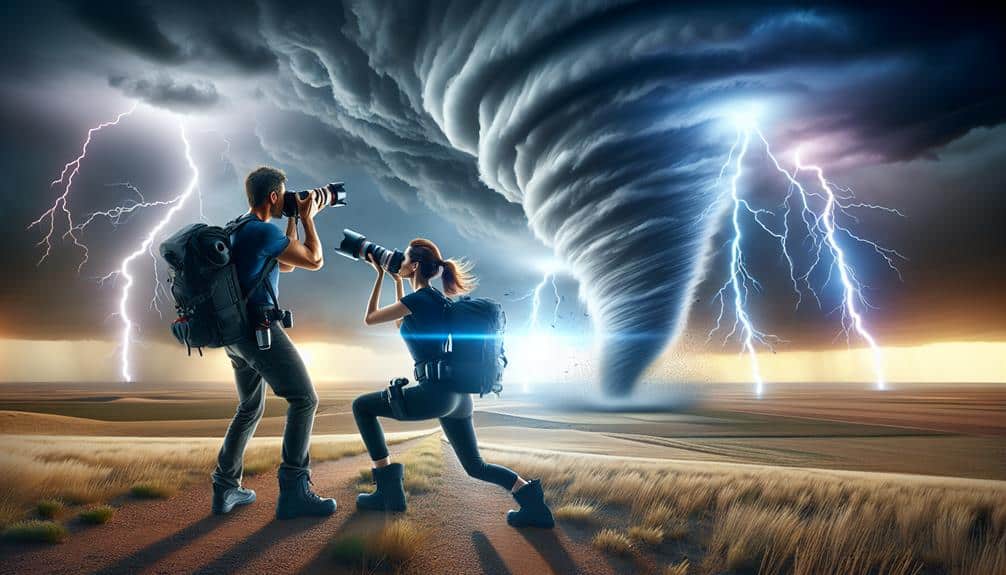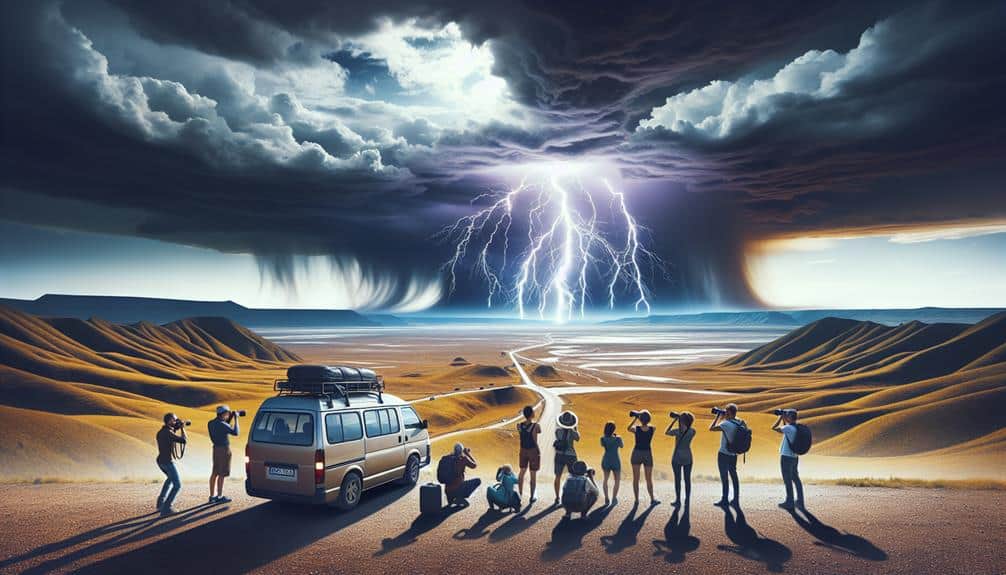We offer data-driven, expert-led storm chasing tours that transform Tornado Alley into a dynamic laboratory for studying severe weather phenomena. Our tours cover the Great Plains, targeting states like Oklahoma, Kansas, Nebraska, and Texas, which experience over 500 tornadoes annually. Guided by seasoned meteorologists, we analyze real-time data, weather models, and radar to predict storms and guarantee safety. Equipped with state-of-the-art weather instruments, emergency gear, and communication devices, our teams maintain precise scientific documentation. With strategic positioning and advanced imaging technology, we capture storm behaviors with clarity and accuracy, uncovering essential insights into severe weather dynamics. Discover the science behind the chase.
Key Points
- Expert-led storm chasing tours offer guided experiences by meteorologists and seasoned storm chasers.
- Participants engage in real-time data analysis, scientific documentation, and educational briefings.
- Tours prioritize safety with state-of-the-art weather monitoring systems and emergency protocols.
- Essential gear includes communication devices, weather monitoring instruments, and emergency supplies.
Top Storm Chasing Destinations
For storm chasing enthusiasts, the Great Plains of the United States, particularly Tornado Alley, offer the most promising destinations for observing severe weather phenomena. We find ourselves drawn to this region because it consistently ranks among the top storm chasing hotspots. The combination of flat terrain and atmospheric conditions here provides an ideal setting for intercepting and studying tornadoes, supercells, and other extreme weather events.
Tornado Alley, spanning states like Oklahoma, Kansas, Nebraska, and Texas, is particularly renowned for its high frequency of tornadoes. Data from the National Weather Service indicates that these states collectively experience over 500 tornadoes annually, offering numerous opportunities for both the adrenaline rush and the pursuit of scientific research. The region's unique geography and meteorological patterns make it a natural laboratory for understanding severe weather dynamics.
Chasing storms in Tornado Alley isn't just about thrill-seeking; it's also a critical endeavor for advancing our understanding of extreme weather. By gathering real-time data on storm structure, wind speeds, and precipitation, we contribute to improving forecasting models and developing better warning systems. Hence, the Great Plains not only satisfy our quest for freedom and adventure but also serve a higher scientific purpose.
Expert-Led Tours
As we explore the Great Plains for storm chasing, expert-led tours offer a structured and data-rich approach to observing these powerful weather events. These tours are guided by meteorologists and seasoned storm chasers who provide us with invaluable insights into weather patterns and storm dynamics. Their expertise guarantees that we not only witness breathtaking phenomena but also collect meaningful data for our field research.
Expert-led tours generally follow a strategic plan, focusing on regions with the highest probability of severe weather. Here's what we can expect:
- Real-Time Data Analysis: Using advanced meteorological tools, our guides interpret weather models and radar data to predict storm development and movement.
- Scientific Documentation: We participate in field research by recording observations, taking photographs, and even measuring atmospheric conditions.
- Educational Briefings: Before and after each chase, our guides hold briefings to explain the day's weather patterns, storm structures, and the scientific principles behind them.
Safety Measures and Protocols
Ensuring our safety during storm chasing tours involves strict adherence to well-defined protocols and backup plans. We prioritize emergency readiness and communication by equipping each vehicle with state-of-the-art weather monitoring systems and satellite phones to maintain constant contact with local weather stations. This guarantees we can receive real-time updates and warnings.
Risk management starts with a thorough briefing where we analyze current storm data and weather models. By understanding the storm's behavior and potential paths, we can make informed decisions and avoid unnecessary dangers. Further, our expert guides constantly evaluate the storm's evolution, adjusting routes as needed to maintain safety.
Group dynamics play a vital role in our strategy. We divide participants into smaller, manageable subgroups, each led by experienced guides trained in first aid and emergency response. This structure not only facilitates effective communication but also allows us to maintain order in high-stress situations.
We employ data-driven approaches to minimize risks, using historical storm data to predict potential hazards. Our backup plans include predefined evacuation routes and safe zones. By combining analytical depth with technical precision, we make sure that our pursuit of scientific knowledge doesn't compromise our safety.
Essential Gear for Storm Chasing
Equipping ourselves with the right gear is crucial to effectively and safely conduct storm chasing operations. We need to be prepared for rapidly changing weather conditions, and our equipment should reflect that.
Let's break down the essential gear into three main categories:
- Emergency Supplies: Safety is our top priority. We should carry a first-aid kit, roadside flares, and high-energy snacks. These items are essential in handling minor injuries, signaling for help, and maintaining energy levels during long hours in the field.
- Communication Devices: Staying connected is crucial. Reliable communication devices like satellite phones, two-way radios, and mobile Wi-Fi hotspots keep us in touch with our team and emergency services. They allow us to receive real-time weather updates and coordinate our movements effectively.
- Weather Monitoring Instruments: Data drives our decisions. Portable weather stations, anemometers, and barometers provide precise measurements of wind speed, atmospheric pressure, and other crucial metrics. These tools help us predict storm behavior and adjust our strategies accordingly.
Capturing the Perfect Storm

To capture the perfect storm, we need to strategically position ourselves using real-time data and advanced imaging technology. By leveraging satellite feeds, Doppler radar, and on-site weather stations, we can pinpoint the exact location of developing meteorological phenomena. Our storm research hinges on the precision of this data, allowing us to anticipate storm paths and intensities.
Deploying high-resolution cameras and drones, we document the awe-inspiring power of nature with unparalleled clarity. The adrenaline rush of storm photography isn't just about the visual spectacle; it's about capturing data that contributes to our understanding of storm dynamics. We set up time-lapse sequences and high-speed video to dissect every lightning strike and cloud formation.
Our team uses mobile apps to access real-time data streams, ensuring we're always a step ahead. We rely on ensemble forecasting models that aggregate data from multiple sources to improve accuracy. By combining this technology with our field expertise, we enhance the safety and effectiveness of our expeditions.
In essence, capturing the perfect storm is a balance of art and science. It's where the thrill of the chase meets the rigor of scientific inquiry, providing us with both an adrenaline rush and valuable insights into the natural world.
Frequently Asked Questions
What Is the Best Time of Year for Storm Chasing Tours?
The best time for storm chasing tours is late spring, particularly May and June. We should choose best locations like Tornado Alley and follow strict safety precautions to guarantee both thrilling experiences and protection.
How Much Do Storm Chasing Tours Typically Cost?
When it comes to storm chasing tours, the price can vary like the wind. Tour price comparisons show costs ranging from $2,000 to $5,000. We can find budget-friendly options through thorough research and early bookings.
Are Meals and Accommodations Included in the Tour Packages?
Regarding the current question, tour logistics typically include accommodations but often exclude meals. Analyzing included amenities reveals variability; some packages offer breakfast, while others leave all meals at participants' discretion, ensuring flexibility and freedom.
Can Children or Pets Join Storm Chasing Tours?
Who wouldn't want a toddler or a Great Dane in a tornado? Safety considerations and group dynamics dictate age restrictions. Educational opportunities abound, but we prioritize data-driven safety measures over reckless freedom when including children or pets.
What Physical Fitness Level Is Required for Storm Chasing?
We need a moderate fitness level for storm chasing. We'll carry equipment, and follow safety precautions. Data shows that physical readiness guarantees we can handle unexpected challenges and maximize our safety and freedom during the chase.


